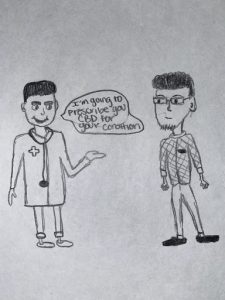The endocannabinoid system is a naturally occurring system within the brain. Researchers have been looking at CBD and THC, which can both be extracted from cannabis, as therapeutics. CBD and THC are chemically similar to the body’s endogenous (natural) endocannabinoids. Research has shown promising results, so doctors have been starting to prescribe medical marijuana to patients instead of alternative drugs. So how has this impacted drug abuse?

In The Brain
First, it is important to understand the endocannabinoid system (ECS) in the brain. The ECS has retrograde signaling and involves several receptors and ligands. Two of the major endogenous endocannabinoids (eCB) are Anandamide (AEA) and 2-Arachidonoylglycerol (2-AG). Also, the CB1 and CB2 receptors are the most prevalent receptors in this system. Both receptors are G-protein coupled receptors (GPCRs). This means that when a ligand binds, G-proteins are activated.
Activated CB1 and CB2 receptors result in a signaling cascade that releases neurotransmitters from the postsynaptic neuron which travels back to the presynaptic neuron. These signals then modulate the presynaptic neuron’s signaling, effecting all signaling done by the presynaptic neuron. The two major endocannabinoids, along with exogenous cannabinoids CBD and THC, bind to the cannabinoid 1 (CB1) receptor. The CB1 receptor is located on presynaptic neurons and mediates the central nervous system’s (CNS) effects. AEA and 2-AG activate the CB1 receptor, which regulates adenylate cyclase activity and inhibits cAMP, voltage-gated potassium channels, calcium channels, and neurotransmitter release.
Next is the cannabinoid 2 (CB2) receptor. The CB2 receptor is mainly found on microglia and is involved with the immune system, including inflammation. AEA and 2-AG are agonists for the cannabinoid receptors and are triggered by an influx of calcium at postsynaptic sites after synaptic activity. Overall, the eCB system mediates a variety of events including synaptic plasticity, learning and memory, pain perception, neuroprotection, inflammation and mood.

Medical Marijuana and Drug Abuse
As medical marijuana is becoming legal, doctors are switching to marijuana or CBD as a therapeutic in replacement of other medications. This is significantly decreasing the amount of addictions and overdoses for several reasons. First, the majority of people who get addicted to opiates were once prescribed them. So, instead of prescribing opiates for pain management, doctors are prescribing medical marijuana or CBD. Second, people who are already addicted to opiates are willingly switching to marijuana, therefore reducing the amount of addictions and overdoses. Same goes for anxiety prescriptions. Since marijuana and CBD have been shown to reduce anxiety, people are using it as a therapeutic instead of other medication that pertain to anxiety, such as Xanax. Further, showing a third way medical marijuana is reducing drug abuse. Lastly, marijuana has been shown to induce a “forgetting effect” by stimulating the part of the brain that controls memory. This can be helpful for people who are struggling with addiction by reducing cravings and reducing the memory related to drug use. Potentially, resulting in a fourth way medical marijuana is reducing drug abuse.
